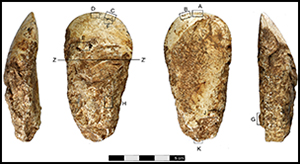Crossref Citations
This article has been cited by the following publications. This list is generated based on data provided by
Crossref.
2015.
Current Bibliography of the History of Science and Its Cultural Influences, 2015.
Isis,
Vol. 106,
Issue. S1,
p.
i.
Neri, Leee Anthony M.
Pawlik, Alfred F.
Reepmeyer, Christian
Mijares, Armand Salvador B.
and
Paz, Victor J.
2015.
Mobility of early islanders in the Philippines during the Terminal Pleistocene/Early Holocene boundary: pXRF-analysis of obsidian artefacts.
Journal of Archaeological Science,
Vol. 61,
Issue. ,
p.
149.
Reepmeyer, Christian
O'Connor, Sue
Mahirta
Maloney, Tim
and
Kealy, Shimona
2016.
Late Pleistocene/early Holocene maritime interaction in Southeastern Indonesia – Timor Leste.
Journal of Archaeological Science,
Vol. 76,
Issue. ,
p.
21.
Ingicco, T.
Piper, P. J.
Amano, N.
Paz, V. J.
and
Pawlik, A. F.
2017.
Biometric Differentiation of Wild Philippine Pigs from Introduced Sus scrofa in Modern and Archaeological Assemblages.
International Journal of Osteoarchaeology,
Vol. 27,
Issue. 5,
p.
768.
O’Connor, Sue
Louys, Julien
Kealy, Shimona
and
Samper Carro, Sofía C.
2017.
Hominin Dispersal and Settlement East of Huxley’s Line.
Current Anthropology,
Vol. 58,
Issue. S17,
p.
S567.
2017.
First Islanders.
p.
131.
Johnson, Lucille Lewis
2018.
Encyclopedia of Coastal Science.
p.
1.
Reepmeyer, Christian
O'Connor, Sue
Mahirta
Kealy, Shimona
and
Maloney, Tim
2019.
Kisar, a small island participant in an extensive maritime obsidian network in the Wallacean Archipelago.
Archaeological Research in Asia,
Vol. 19,
Issue. ,
p.
100139.
Boulanger, Clara
Ingicco, Thomas
Piper, Philip J.
Amano, Noel
Grouard, Sandrine
Ono, Rintaro
Hawkins, Stuart
and
Pawlik, Alfred F.
2019.
Coastal Subsistence Strategies and Mangrove Swamp Evolution at Bubog I Rockshelter (Ilin Island, Mindoro, Philippines) from the Late Pleistocene to the mid-Holocene.
The Journal of Island and Coastal Archaeology,
Vol. 14,
Issue. 4,
p.
584.
Bellwood, Peter
2019.
The Spice Islands in Prehistory: Archaeology in the Northern Moluccas, Indonesia.
Johnson, Lucille Lewis
2019.
Encyclopedia of Coastal Science.
p.
55.
Fuentes, Riczar
Ono, Rintaro
Nakajima, Naoki
Nishizawa, Hiroe
Siswanto, Joko
Aziz, Nasrullah
Sriwigati
Sofian, Harry Octavianus
Miranda, Tatiana
and
Pawlik, Alfred
2019.
Technological and behavioural complexity in expedient industries: The importance of use-wear analysis for understanding flake assemblages.
Journal of Archaeological Science,
Vol. 112,
Issue. ,
p.
105031.
Pawlik, Alfred
Crozier, Rebecca
Fuentes, Riczar
Wood, Rachel
and
Piper, Philip
2019.
Burial traditions in early Mid-Holocene Island Southeast Asia: new evidence from Bubog-1, Ilin Island, Mindoro Occidental.
Antiquity,
Vol. 93,
Issue. 370,
p.
901.
Pawlik, Alfred F.
and
Piper, Philip J.
2019.
The Philippines fromc.14,000 to 4,000 cal.bpin Regional Context.
Cambridge Archaeological Journal,
Vol. 29,
Issue. 1,
p.
1.
Bulbeck, David
2019.
Encyclopedia of Global Archaeology.
p.
1.
Shipton, Ceri
O’Connor, Sue
Reepmeyer, Christian
Kealy, Shimona
and
Jankowski, Nathan
2020.
Shell Adzes, Exotic Obsidian, and Inter-Island Voyaging in the Early and Middle Holocene of Wallacea.
The Journal of Island and Coastal Archaeology,
Vol. 15,
Issue. 4,
p.
525.
Ono, Rintaro
Fuentes, Riczar
Pawlik, Alfred
Sofian, Harry Octavianus
Sriwigati
Aziz, Nasrullah
Alamsyah, Nico
and
Yoneda, Minoru
2020.
Island migration and foraging behaviour by anatomically modern humans during the late Pleistocene to Holocene in Wallacea: New evidence from Central Sulawesi, Indonesia.
Quaternary International,
Vol. 554,
Issue. ,
p.
90.
Ono, Rintaro
Pawlik, Alfred
and
Fuentes, Riczar
2020.
Pleistocene Archaeology - Migration, Technology, and Adaptation.
Bulbeck, David
2020.
Encyclopedia of Global Archaeology.
p.
6037.
Fuentes, Riczar
Ono, Rintaro
Carlos, Jane
Kerfant, Celine
Sriwigati
Miranda, Tatiana
Aziz, Nasrullah
Sofian, Harry Octavianus
and
Pawlik, Alfred
2020.
Stuck within notches: Direct evidence of plant processing during the last glacial maximum to Holocene in North Sulawesi.
Journal of Archaeological Science: Reports,
Vol. 30,
Issue. ,
p.
102207.
